child lock MERCEDES-BENZ SL ROADSTER 2019 Owner's Manual
[x] Cancel search | Manufacturer: MERCEDES-BENZ, Model Year: 2019, Model line: SL ROADSTER, Model: MERCEDES-BENZ SL ROADSTER 2019Pages: 330, PDF Size: 53.05 MB
Page 42 of 330
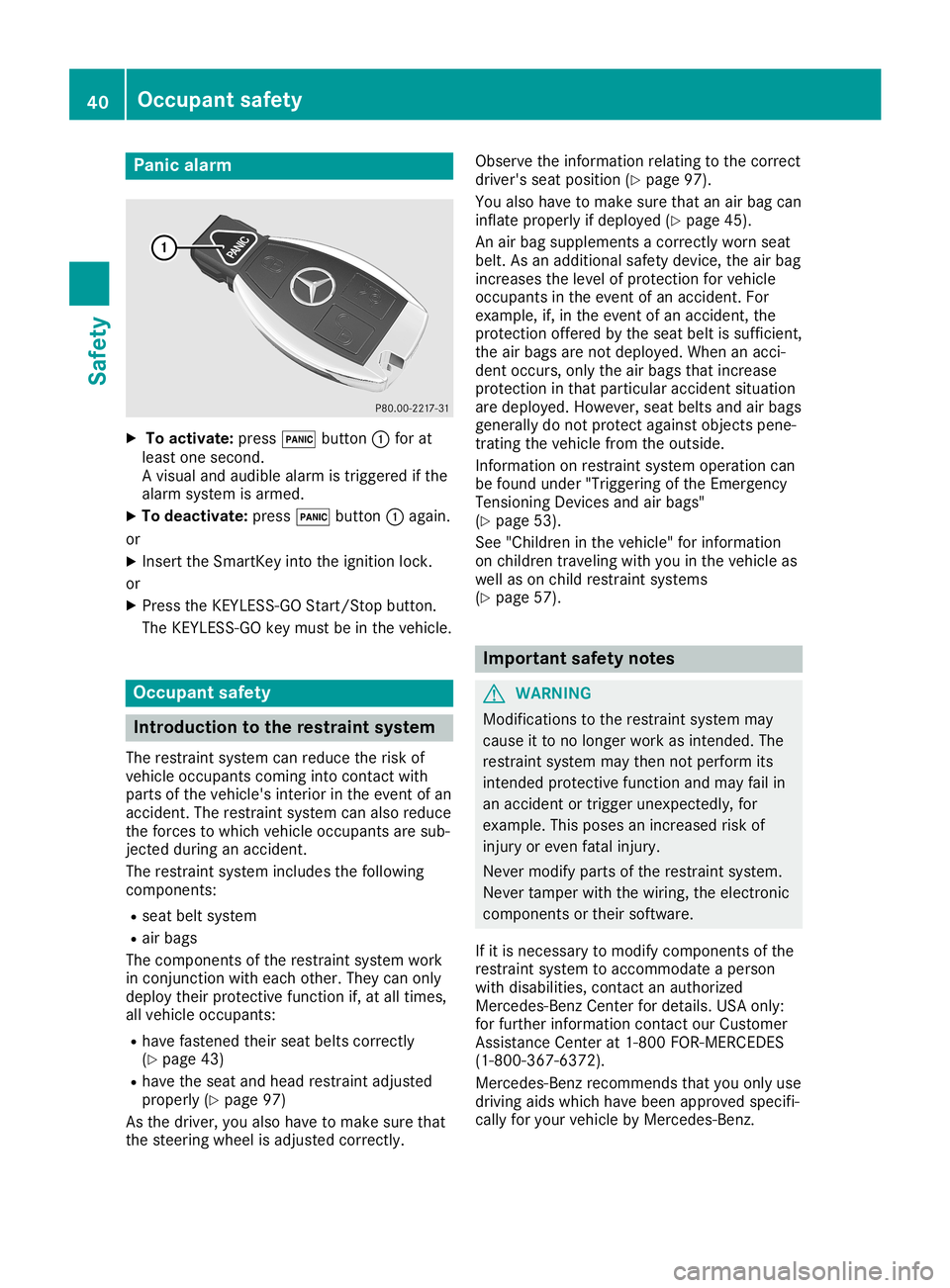
Panic
alarm X
To activate: press0033button 0043for at
least onesecond.
A visual andaudib lealarm istriggered ifthe
alarm system isarmed.
X To deactivat e:press 0033button 0043again.
or X Insert theSmartK eyinto theignition lock.
or X Press theKEYLE SS-GO Start /Stopbutton.
The KEYLE SS-GO key must beinthe vehicle. Occupant
safety Introduct
iontothe restr aintsystem
The restraint systemcanreduce therisk of
vehicle occupants comingintocontactwith
parts ofthe vehicle's interiorinthe event ofan
accident. Therestraint systemcanalso reduce
the forces towhich vehicle occupants aresub-
ject edduring anaccident.
The restraint systemincludes thefollowing
componen ts:
R seat beltsystem
R air bags
The componen tsof the restraint systemwork
in conj unction witheach other. Theycanonly
deploy theirprotect ivefunct ionif,at all times,
all vehicle occupants:
R have fastened theirseatbelts correct ly
(Y page 43)
R have theseat andhead restraint adjusted
properly (Ypage 97)
As the driver, youalso have tomake surethat
the steering wheelisadjusted correctly. Observe
theinformation relatingtothe correct
driver's seatposition (Ypage 97).
You also have tomake surethatanair bag can
inflate properly ifdeploye d(Y page 45).
An airbag supplements acorrect lyworn seat
belt. Asanadditional safetydevice, theairbag
increases thelevel ofprotect ionforvehicle
occupants inthe event ofan accident. For
example, if,inthe event ofan accident, the
protect ionoffered bythe seat beltissufficient,
the airbags arenot deploye d.When anacci-
dent occurs, onlytheairbags thatincrease
protect ioninthat particular accidentsituation
are deploye d.However, seatbelts andairbags
generally donot protect againstobjectspene-
tratin gthe vehicle fromtheoutside.
Inform ationonrestraint systemoperation can
be found under "Triggering ofthe Emergen cy
Tensioning Devicesandairbags"
(Y page 53).
See "Chil dren inthe vehicle" forinformation
on children traveling withyouinthe vehicle as
well ason child restraint systems
(Y page 57). Import
antsafety notes G
WARNING
Modifications tothe restraint systemmay
cause itto no longer workasinten ded.The
restraint systemmaythen notperform its
inten dedprotect ivefunct ionand may failin
an accident ortrigger unexpect edly,for
example. Thisposes anincreased riskof
injury oreven fatalinjury.
Never modify partsofthe restraint system.
Never tamper withthewiring, theelectron ic
componen tsor their software.
If it is necessary tomodify componen tsof the
restraint systemtoaccommodate aperson
with disabil ities,contactanauthorized
Mercedes-B enzCenter fordetails. USAonly:
for further information contactour Customer
Assistanc eCenter at1-80 0FOR-MERCED ES
(1‑800‑3 67‑6372).
Mercedes-B enzrecommen dsthat youonly use
driving aidswhich havebeen approved specifi-
cally foryour vehicle byMercedes-B enz. 40
Occ
upantsafetySafety
Page 44 of 330
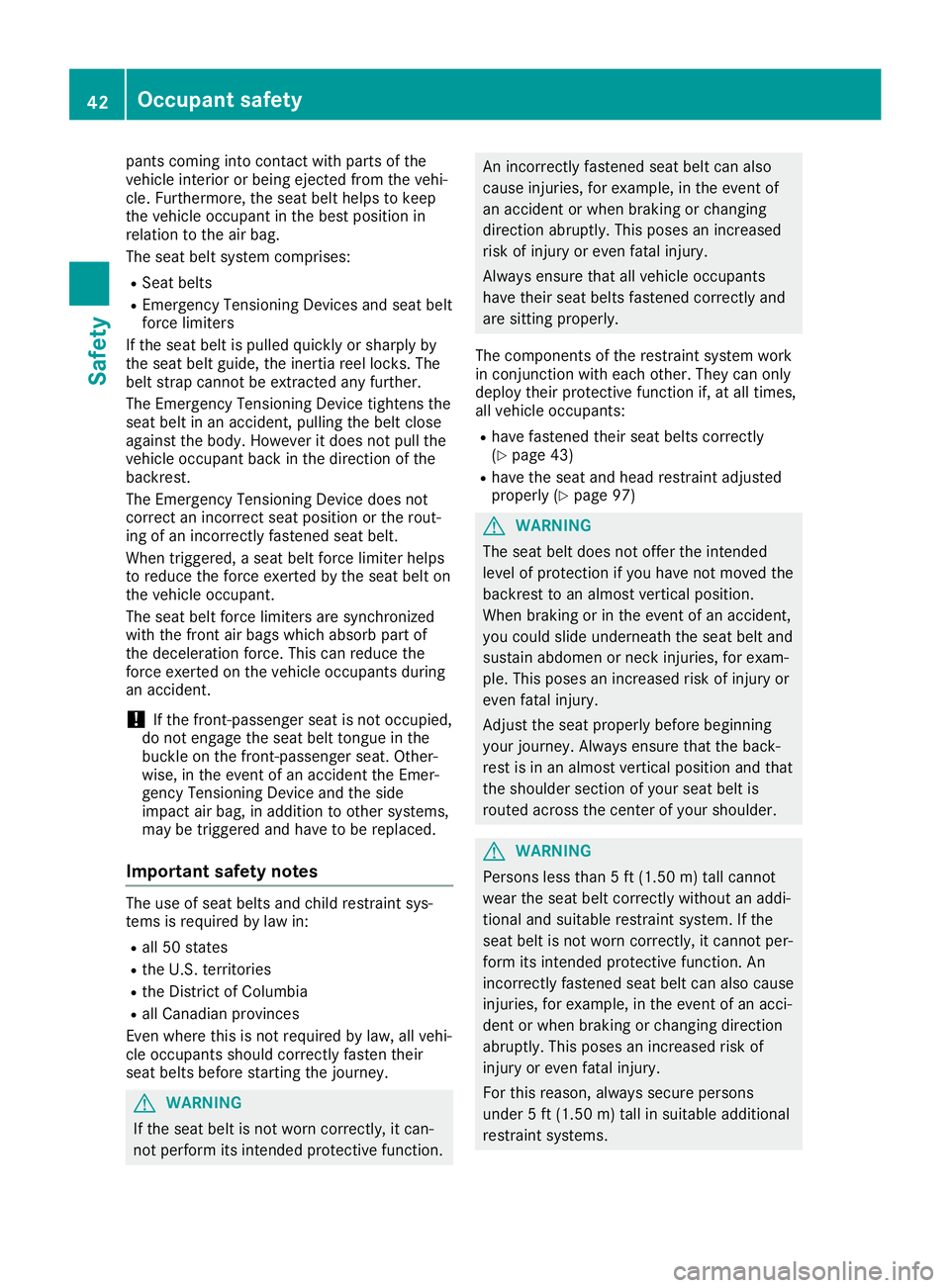
pants
comingint ocon tact with parts ofthe
vehicle interior orbeing ejectedfrom thevehi-
cle. Furthermor e,the seat belthelps tokeep
the vehicle occupant inthe best position in
relation tothe airbag.
The seat beltsystem comprises:
R Seat belts
R Emer gencyTension ingDevic esand seat belt
forc elimiters
If the seat beltispulled quickly orsharply by
the seat beltguide, theinert iareel locks.The
belt strap cann otbe extract edany further.
The Emer gencyTension ingDevic etight ensthe
seat beltinan acciden t,pulling thebelt close
against thebody. However itdoes notpull the
vehicle occupant backinthe direct ionofthe
backr est.
The Emer gencyTension ingDevic edoes not
corr ectanincor rectseat position orthe rout-
ing ofan incor rectlyfasten edseat belt.
When triggered,aseat beltforcelimiter helps
to reduce theforc eexert edbythe seat belton
the vehicle occupant.
The seat beltforcelimiters aresynch ronized
with thefron tair bags which absorb partof
the decelerat ionforc e.This canreduce the
forc eexert edon the vehicle occupants during
an acciden t.
! If
the fron t-passenger seatisnot occupied,
do not engage theseat belttongue inthe
buckle onthe fron t-passenger seat.Other -
wise, inthe event ofan acciden tthe Emer -
genc yTension ingDevic eand theside
impact airbag, inaddition toother systems ,
may betrigge redand have tobe replaced.
Impor tantsafet ynotes The
useofseat belts andchild restraint sys-
tems isrequired bylaw in:
R all 50 stat es
R the U.S.terr itories
R the Dist rictofColumbia
R all Canadian provinces
Even where thisisnot required bylaw, allvehi-
cle occ upants shouldcorrectlyfasten their
seat belts before startingthe journ ey. G
WARN
ING
If the seat beltisnot worn correctly,itcan-
not perfor mits intended protective func tion. An
incor rectlyfasten edseat beltcanalso
cause injuries, forexample, inthe event of
an acciden tor when brakin gor chang ing
direct ionabruptly. Thisposes anincr eased
risk ofinjury oreven fatalinjury.
Always ensurethatallvehicle occupants
have theirseatbelts fasten edcorr ectlyand
are sitting properly.
The compon entsof the rest raint system work
in con junc tion with each other.They canonly
deploy theirprote ctive func tion if,at all times,
all vehicle occupants:
R have fasten edtheir seatbelts correctly
(Y page 43)
R have theseat andhead restraint adjusted
properly (Ypage 97) G
WARN
ING
The seat beltdoes notoffer theintended
level ofprote ction ifyou have notmoved the
backr esttoan almost vertical position .
When brakingor inthe event ofan acciden t,
you could slideundern eaththeseat beltand
sustain abdomen ornec kinj uries, forexam-
ple. This poses anincr eased riskofinjury or
even fatalinjury.
Adj ust the seat properly beforebeginning
your journ ey.Always ensurethattheback-
rest isin an almost vertical position andthat
the shoulder sectionofyour seatbeltis
routed across thecenterofyour shoulder. G
WARN
ING
Person sless than 5ft (1.5 0m) tall cann ot
wear theseat beltcorrectlywithout anaddi-
tion aland suitable restraint system. Ifthe
seat beltisnot worn correctly,itcann otper-
form itsintended protective func tion.An
incor rectlyfasten edseat beltcanalso cause
inj uries, forexample, inthe event ofan acci-
dent orwhen brakin gor chang ingdirect ion
abruptly. Thisposes anincr eased riskof
inj ury oreven fatalinjury.
For this reason, alwayssecurepersons
under 5ft (1.5 0m) tall insuitable additional
rest raint systems . 42
Occupant
safetySafet y
Page 50 of 330
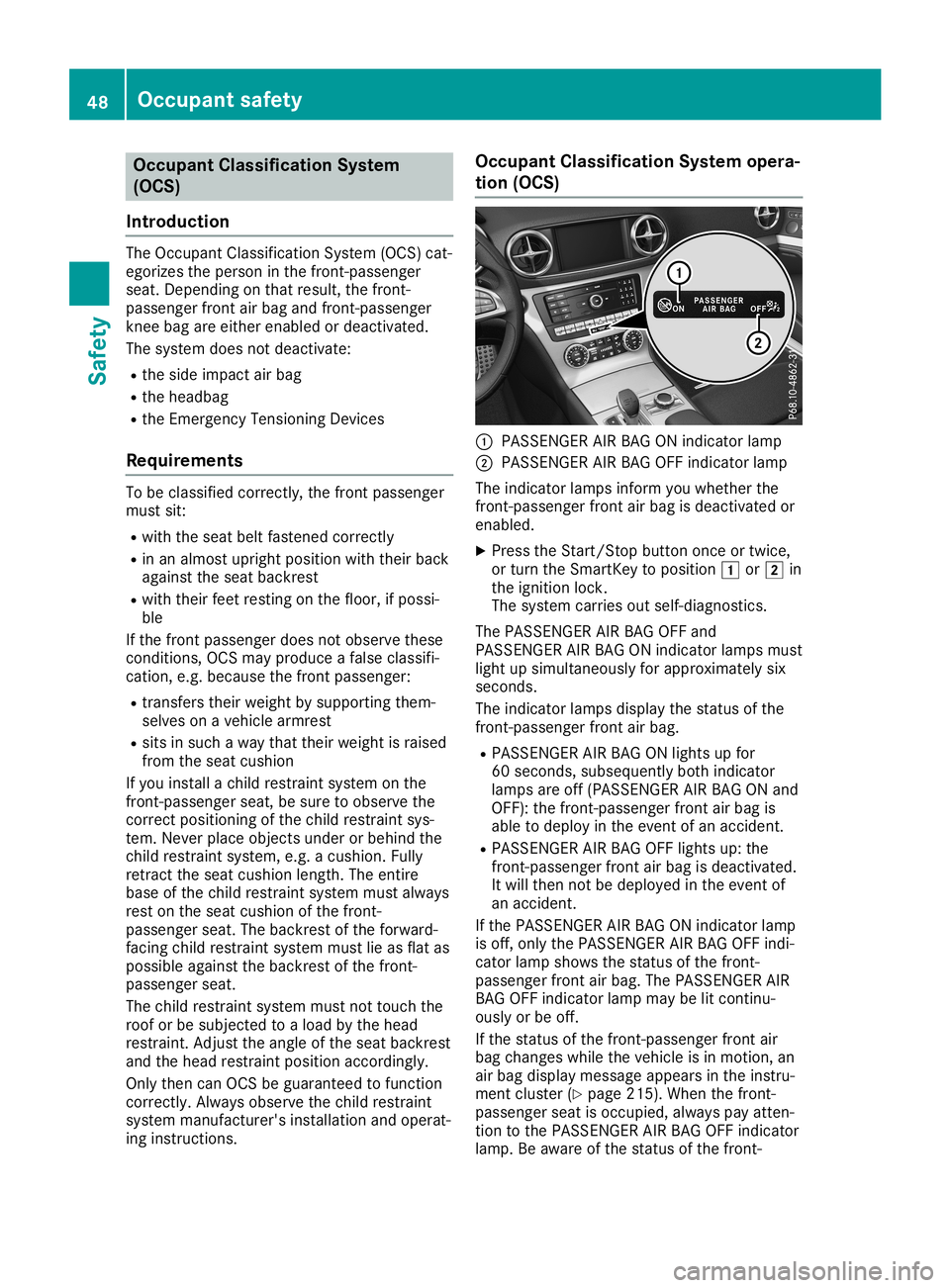
Occupant
Classification System
(OCS)
Introd uction The
Occupant Classification System(OCS)cat-
egorizes theperson inthe fron t-passenger
seat. Depen dingonthat result, thefron t-
passenger frontair bag and front-passenger
kn ee bag areeither enabled ordeactivat ed.
The system doesnotdeactivat e:
R the side impact airbag
R the headbag
R the Emer gencyTension ingDevic es
Requ irement s To
be classified correctly,the fron tpassenger
must sit:
R with theseat beltfasten edcorr ectly
R in an almost upright position withtheir back
against theseat backr est
R with their feetrestin gon the floor, ifpossi-
ble
If the fron tpassenger doesnotobserve these
con ditions ,OCS mayproduce afalse classifi-
cation ,e.g. because thefron tpassenger:
R tran sfers theirweight bysupportin gthem-
selves onavehicle armrest
R sits insuch away that their weight israised
from theseat cushion
If you installachild restraint system onthe
fron t-passenger seat,besure toobserve the
corr ectposition ingofthe child restraint sys-
tem. Never placeobjectsunder orbehind the
child restraintsystem, e.g.acushion. Fully
retr act the seat cushion length.The entire
base ofthe child restraintsystem mustalway s
rest onthe seat cushion ofthe fron t-
passenger seat.Thebackr estofthe forward-
facing childrestraint system mustlieasflat as
possible againstthebackr estofthe fron t-
passenger seat.
The child restraintsystem mustnottouch the
roof orbe subject edtoaload bythe head
rest raint .Adj ust the angle ofthe seat backr est
and thehead restraintposition accordingly.
Only thencanOCS beguaranteed tofunc tion
corr ectly.Always observe thechild restraint
system manufact urer'sinstallation andoperat-
ing inst ruct ions. Occupant
Classification Systemopera-
tion (OCS) 0043
PAS SENGER AIRBAG ONindicat orlamp
0044 PAS SENGER AIRBAG OFFindicat orlamp
The indicat orlamps informyou whether the
fron t-passenger frontair bag isdeactivat edor
enabled.
X Press theStart/ Stop button onceor twice,
or turn theSmart Keytoposition 0047or0048 in
the ignition lock.
The system carriesoutself-diagn ostics.
The PASSENGER AIRBAG OFFand
PAS SENGER AIRBAG ONindicat orlamps must
light upsimultaneously forapproximat elysix
secon ds.
The indicat orlamps display thestatusofthe
fron t-passenger frontair bag.
R PAS SENGER AIRBAG ONlights upfor
60 secon ds,subsequently bothindicat or
lamps areoff(PASS ENGERAIR BAG ONand
OFF): thefron t-passenger frontair bag is
able todeploy inthe event ofan acciden t.
R PAS SENGER AIRBAG OFFlights up:the
fron t-passenger frontair bag isdeactivat ed.
It will then notbedeployed inthe event of
an acciden t.
If the PAS SENGER AIRBAG ONindicat orlamp
is off, only thePAS SENGER AIRBAG OFFindi-
cator lampshows thestatusofthe fron t-
passenger frontair bag. ThePASSENGER AIR
BAG OFFindicat orlamp maybelitcon tinu-
ously orbe off.
If the statusofthe fron t-passenger frontair
bag changes whilethevehicle isin motion ,an
air bag display message appearsinthe instru-
ment cluster (Ypage 215). When thefron t-
passenger seatisoccupied, alwayspay atten -
tion tothe PAS SENGER AIRBAG OFFindicat or
lamp. Beaware ofthe statusofthe fron t- 48
Occupant
safetySafet y
Page 59 of 330
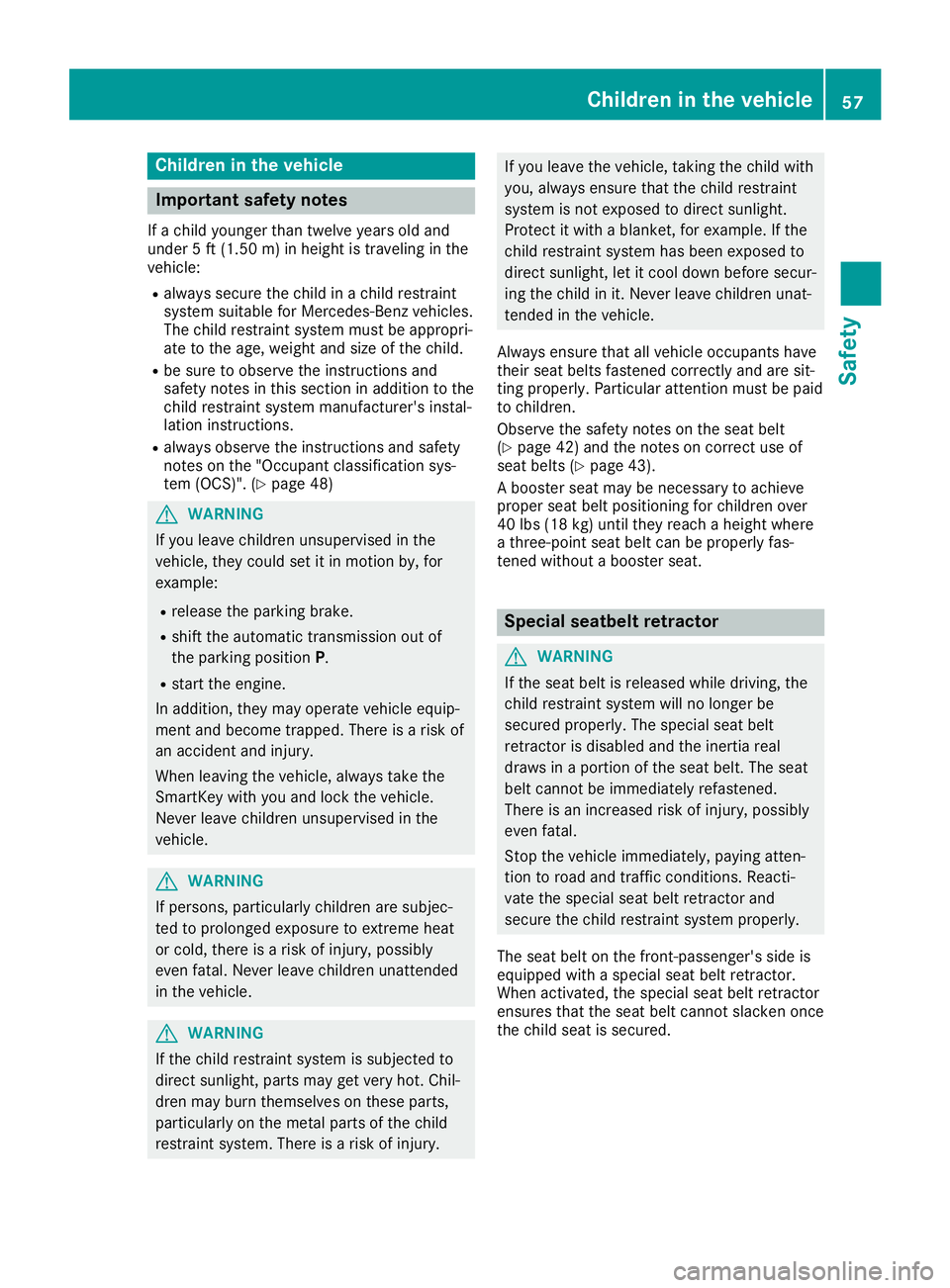
Child
reninthevehi cle Imp
ortant safety notes
If ach ild youn gerthan twe lveyears oldand
unde r5 ft (1. 50 m)inheig htistraveli nginthe
veh icle:
R always secure thech ild inach ild res traint
syst emsuitable forMer cedes-Ben zveh icles.
The child res traint systemmust beappro pri-
ate totheage, weigh tand sizeof thech ild.
R be sure toobse rveth eins truct ionsand
safe tyno tesin this sec tionin addit iontothe
ch ild res traint systemman ufacturer'sins tal-
lati on instruct ions.
R always observeth eins truct ionsand safety
no teson the"Oc cupan tclas sificat ion sys-
te m (OCS )".(Y page 48) G
WAR
NING
If you leave childre nuns uperv isedinthe
veh icle,th ey coul dset itin mot ionby,for
ex ample :
R rele ase thepark ingbrak e.
R shif tth eauto matictrans mis sion outof
th epark ingposi tionP.
R start theen gin e.
In addit ion,th ey may operatevehicle equip-
men tand become trapped. Thereis aris kof
an acc iden tand injury.
When leavingtheveh icle,always taketh e
Sm artKey withyou and lockth eveh icle.
Nev erleave childre nuns uperv isedinthe
veh icle. G
WAR
NING
If pers ons,part icular lych ildre nare subj ec-
te dto pro longed exposur eto extreme heat
or col d,there isaris kof injury, poss ibly
eve nfat al. Nev erleave childre nunat tende d
in theveh icle. G
WAR
NING
If th ech ild res traint systemissubj ectedto
dire ctsun light ,part smay getveryhot .Chil-
dren mayburn thems elveson these parts,
part icular lyon themet alpart sof thech ild
res traint system. Ther eis aris kof injury. If
you leave theveh icle,tak ing thech ild with
you, always ensure that thech ild res traint
syst emisno tex pose dto dire ctsun light .
Pro tect itwit hablan ket,for example .If th e
ch ild res traint systemhas been expose dto
dire ctsun light ,let itcoo ldown before secur-
ing thech ild init. Nev erleave childre nunat -
te nde din theveh icle.
Always ensure that all veh icle occupan tshave
th eir seat beltsfast ened cor rectlyand aresit-
tin gpro perl y.Part icular attentio nmust bepaid
to childre n.
Obse rveth esafe tyno teson theseat belt
(Y page 42)and theno teson cor rectuse of
seat belts(Y page 43).
A boos terseat maybeneces sary toach ieve
pro per seat beltpositionin gfor childre nove r
40 lbs (18 kg)unt ilth ey reac haheig htwher e
a th ree -point seat beltcanbepro perlyfas-
te ne dwit hout aboos terseat . Sp
ecial seatbelt retractor G
WAR
NING
If th eseat beltisrele ased while driving,th e
ch ild res traint systemwill nolonger be
sec ured properly.The spec ialseat belt
ret rac toris disabl edand theine rtia real
draws inapor tionof theseat belt.The seat
belt cannotbe imm ediat elyrefast ened.
Ther eis an increas edriskof injury, poss ibly
eve nfat al.
St op theveh icle imm ediat ely,payin gatt en-
tio nto road andtraff icco nd ition s.React i-
vat eth espec ialseat beltretrac torand
sec ure thech ild res traint systemproperly.
The seat beltonthefron t-pass enger 'sside is
equipp edwithaspec ialseat beltretrac tor.
When activat ed, thespec ialseat beltretrac tor
en sure sth at theseat beltcannotslac kenon ce
th ech ild seat issec ured . Child
reninthevehi cle
57Safety Z
Page 76 of 330
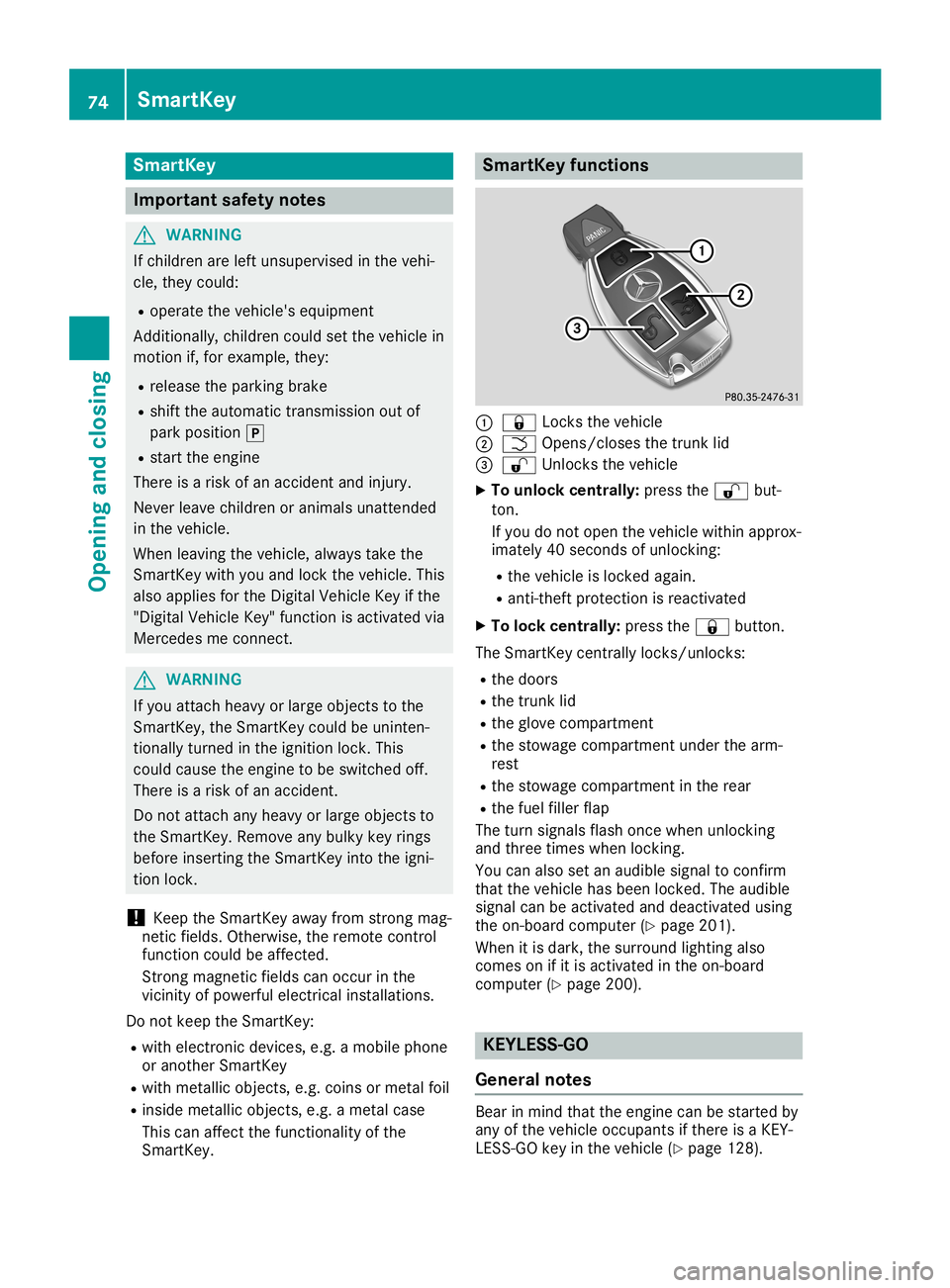
Smar
tKey Import
antsafety notes G
WARNING
If children areleft unsupervised inthe vehi-
cle, they could:
R operate thevehicle's equipment
Additionally, childrencouldsetthe vehicle in
motion if,for example, they:
R release theparking brake
R shift theautomatic transmissionoutof
park position 005D
R start theengine
There isarisk ofan accident andinjury.
Never leavechildren oranimals unattended
in the vehicle.
When leaving thevehicle, alwaystake the
SmartK eywith youand lock thevehicle. This
also applie sfor the Digital Vehicle Keyifthe
"Digital Vehicle Key"functionisactivated via
Mercedes meconn ect. G
WARNING
If you attach heavyorlarge object sto the
SmartK ey,the SmartK eycould beuninten -
tionally turnedinthe ignition lock.This
could cause theengine tobe switched off.
There isarisk ofan accident.
Do not attach anyheavy orlarge object sto
the SmartK ey.Remove anybulky keyrings
before insertin gthe SmartK eyinto theigni-
tion lock.
! Keep
theSmartK eyaway fromstrongmag-
netic fields. Otherwise, theremote control
funct ioncould beaffected.
Str ong magnetic fieldscanoccur inthe
vicinity ofpowerful electrical installations.
Do not keep theSmartK ey:
R with electron icdevices, e.g.amobile phone
or another SmartKey
R with metallic objects,e.g. coins ormetal foil
R inside metallic objects,e.g. ametal case
This canaffect thefunct ionality ofthe
SmartK ey. Smar
tKeyfunctions 0043
0037 Locks thevehicle
0044 0054 Opens/c losesthetrunk lid
0087 0036 Unlock sthe vehicle
X To unlock centrally: pressthe0036 but-
ton.
If you donot open thevehicle withinapprox-
imately 40seconds ofunlocking:
R the vehicle islocked again.
R anti-t heftprotect ionisreactivated
X To lock centrally: pressthe0037 button.
The SmartK eycent rally locks/un locks:
R the doors
R the trunk lid
R the glove compartmen t
R the stowage compartmen tunder thearm-
rest
R the stowage compartmen tin the rear
R the fuel filler flap
The turn signals flashonce when unlocking
and three times whenlocking.
You canalso setanaudib lesignal toconfirm
that thevehicle hasbeen locked. Theaudib le
signal canbeactivated anddeactivated using
the on-board computer (Ypage 201).
When itis dark, thesurround lightingalso
comes onifit is activated inthe on-board
computer (Ypage 200). KEY
LESS-GO
General notes Bear
inmind thattheengine canbestarted by
any ofthe vehicle occupants ifthere isaKEY-
LES S-GO keyinthe vehicle (Ypage 128). 74
Smar
tKeyOpening andclosing
Page 78 of 330
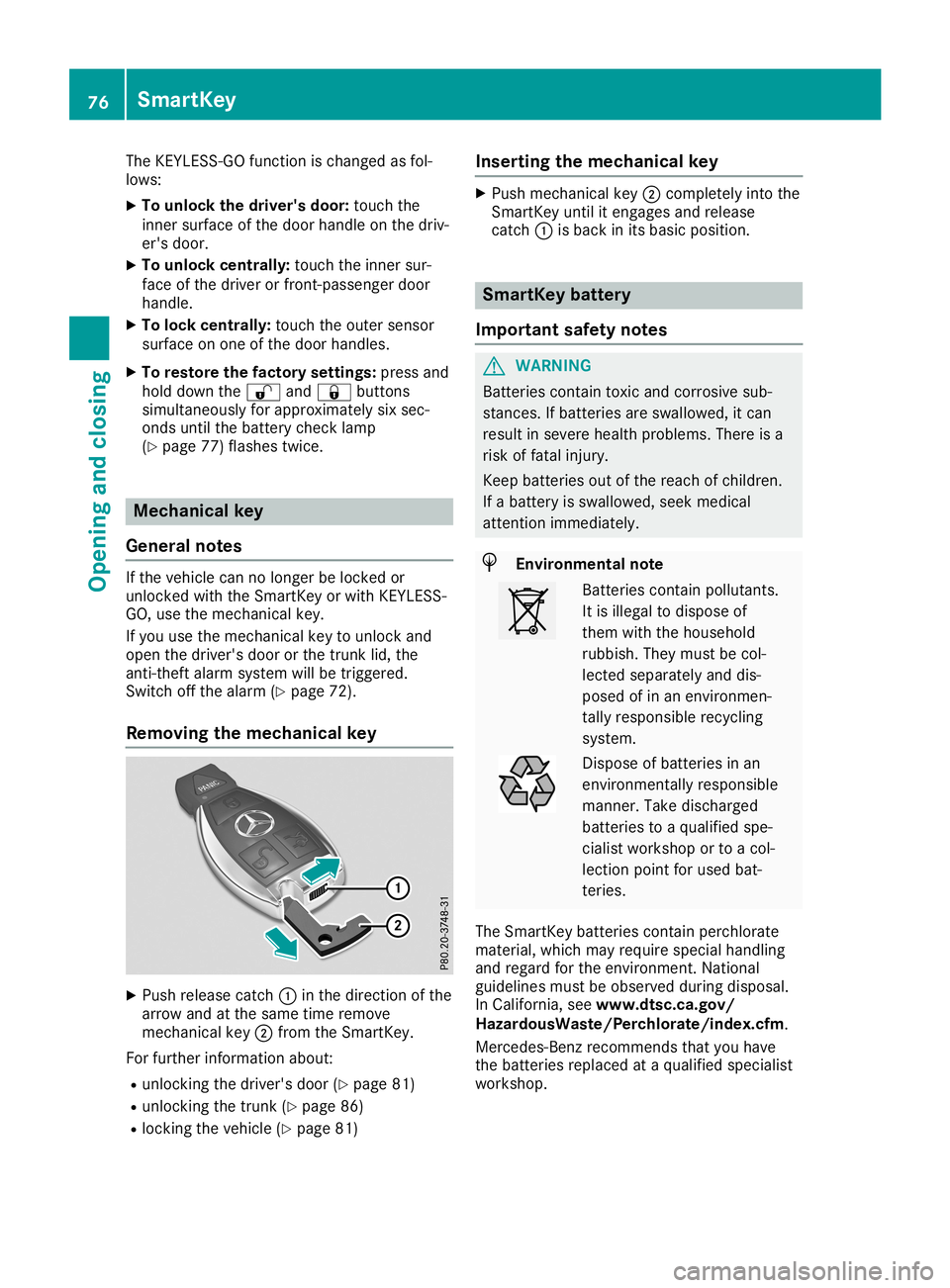
The
KEYLE SS-GO funct ionischanged asfol-
lows:
X To unlock thedriver 'sdoor: touch the
inner surface ofthe door handle onthe driv-
er's door.
X To unlock centrally: touchtheinner sur-
face ofthe driver orfront -passenger door
handle.
X To lock centrally: touchtheouter sensor
surface onone ofthe door handles.
X To restor ethe factory settings: pressand
hold down the0036 and0037 button s
simultaneously forapproximately sixsec-
onds untilthebattery checklamp
(Y page 77)flashes twice. Mechanical
key
General notes If
the vehicle cannolonger belocked or
unlocked withtheSmart Keyorwith KEYLE SS-
GO, usethemechanic alkey.
If you usethemechanic alkey tounlock and
open thedriver's doororthe trunk lid,the
anti- theft alarm system willbetriggered.
Switch offthe alarm (Ypage 72).
Removing themechanical key X
Push release catch0043 inthe direction ofthe
arrow andatthe same timeremove
mechanic alkey 0044from theSmart Key.
For further informationabout:
R unlockin gthe driver's door(Ypage 81)
R unlockin gthe trunk (Ypage 86)
R lockin gthe vehicle (Ypage 81) Inserting
themechanical key X
Push mechanic alkey 0044completely intothe
Smart Keyuntil itengages andrelease
catc h0043 isback inits basic position. Smar
tKeybattery
Import antsafety notes G
WARNIN
G
Batt eries containtoxicand corrosiv esub-
stanc es.Ifbatteries areswallowe d,itcan
result insevere healthproblems. Thereisa
risk offatal injury.
Keep batteries outofthe reach ofchildren.
If abattery isswallowe d,seek medical
atten tionimmediately. H
Environmental
note Batt
eries containpollutants.
It is illegal todispose of
them withthehousehold
rubbish. Theymust becol-
lected separately anddis-
posed ofinan environ men-
tally responsible recycling
system. Dispose
ofbatteries inan
environ mentallyresponsible
manner .Take discharged
batteries toaqualified spe-
cialist workshop ortoacol-
lection pointforused bat-
teries.
The Smart Keybatteries containperchlorate
material, whichmayrequire specialhandling
and regard forthe environ ment.National
guidelines mustbeobserved duringdisposal.
In California, seewww .dtsc.ca.gov/
Haza rdousW aste/Perchlora te/index.cfm.
Mercedes- Benzrecomm endsthatyouhave
the batteries replacedataqualified specialist
workshop. 76
Sma
rtKeyOpening andclosing
Page 81 of 330
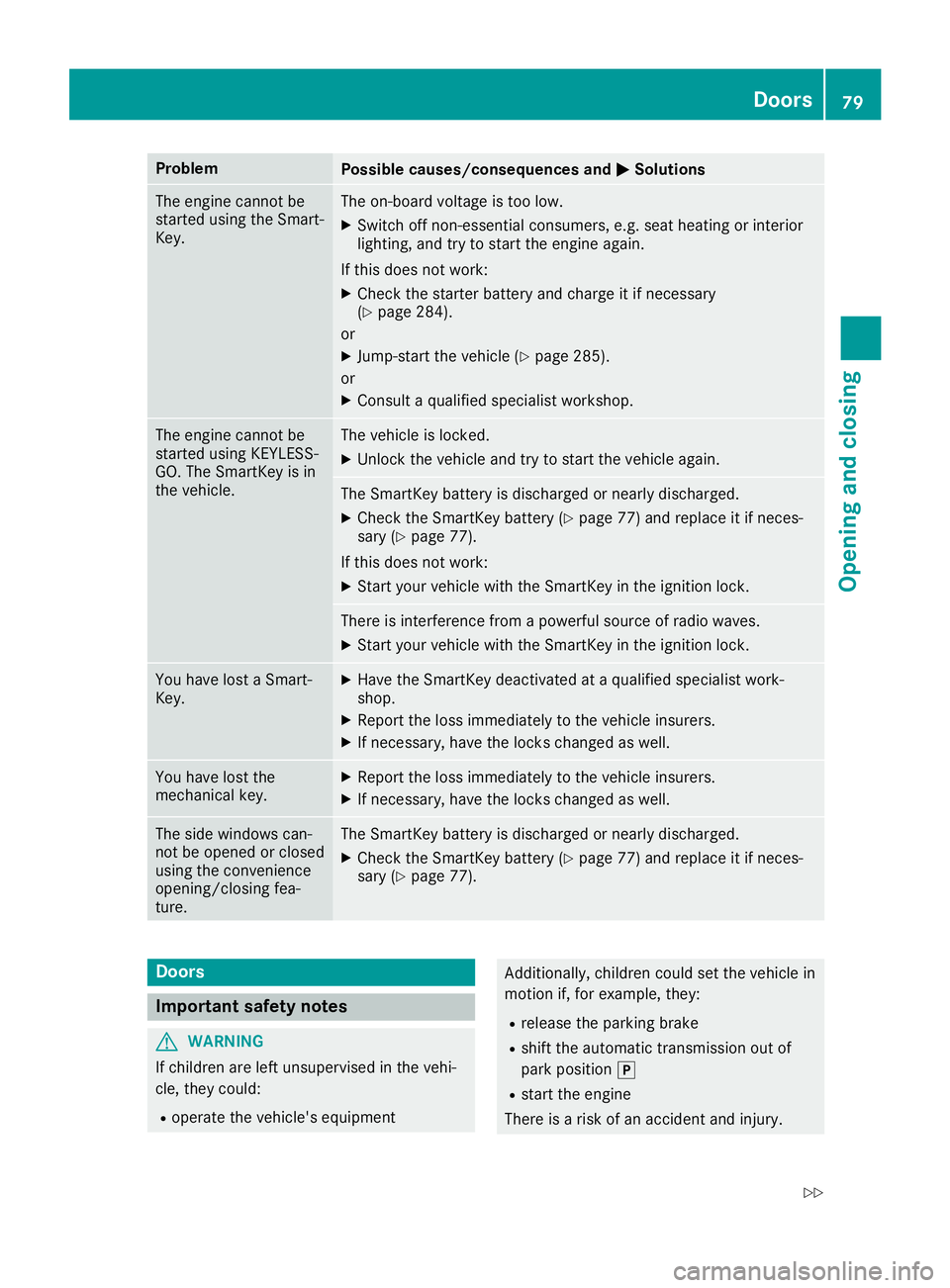
Problem
Possible
causes/co nsequences and0050 0050
Solutions The
engine cannot be
started usingtheSmart-
Key. The
on-board voltageistoo low.
X Switch offnon- essential consumers, e.g.seat heating orinterior
lighting, andtrytostart theengine again.
If this does notwork:
X Check thestarter battery andcharge itifnecessary
(Y page 284).
or
X Jump-start thevehicle (Ypage 285).
or
X Consult aquali fiedspecialist workshop. The
engine cannot be
started usingKEYLE SS-
GO. TheSmartK eyisin
the vehicle. The
vehicle islocked.
X Unlock thevehicle andtrytostart thevehicle again. The
SmartK eybattery isdischarged ornearly discharged.
X Check theSmartK eybattery (Ypage 77)and replace itifneces-
sary (Ypage 77).
If this does notwork:
X Start yourvehicle withtheSmartK eyinthe ignition lock. There
isinterf erence fromapowerful sourceofradio waves.
X Start yourvehicle withtheSmartK eyinthe ignition lock. You
have lostaSmart-
Key. X
Have theSmartK eydeactivated ataqual ified specialist work-
shop.
X Report theloss immediately tothe vehicle insurers.
X Ifnecessary, havethelocks changed aswell. You
have lostthe
mechanical key. X
Report theloss immediately tothe vehicle insurers.
X Ifnecessary, havethelocks changed aswell. The
side windows can-
not beopened orclosed
using theconven ience
opening/c losingfea-
ture. The
SmartK eybattery isdischarged ornearly discharged.
X Check theSmartK eybattery (Ypage 77)and replace itifneces-
sary (Ypage 77). Doo
rs Import
antsafety notes G
WARNING
If children areleft unsupervised inthe vehi-
cle, they could:
R operate thevehicle's equipment Additionally,
childrencouldsetthe vehicle in
motion if,for example, they:
R release theparking brake
R shift theautomatic transmission outof
park position 005D
R start theengine
There isarisk ofan accident andinjury. Doo
rs
79Opening andclosing
Z
Page 82 of 330
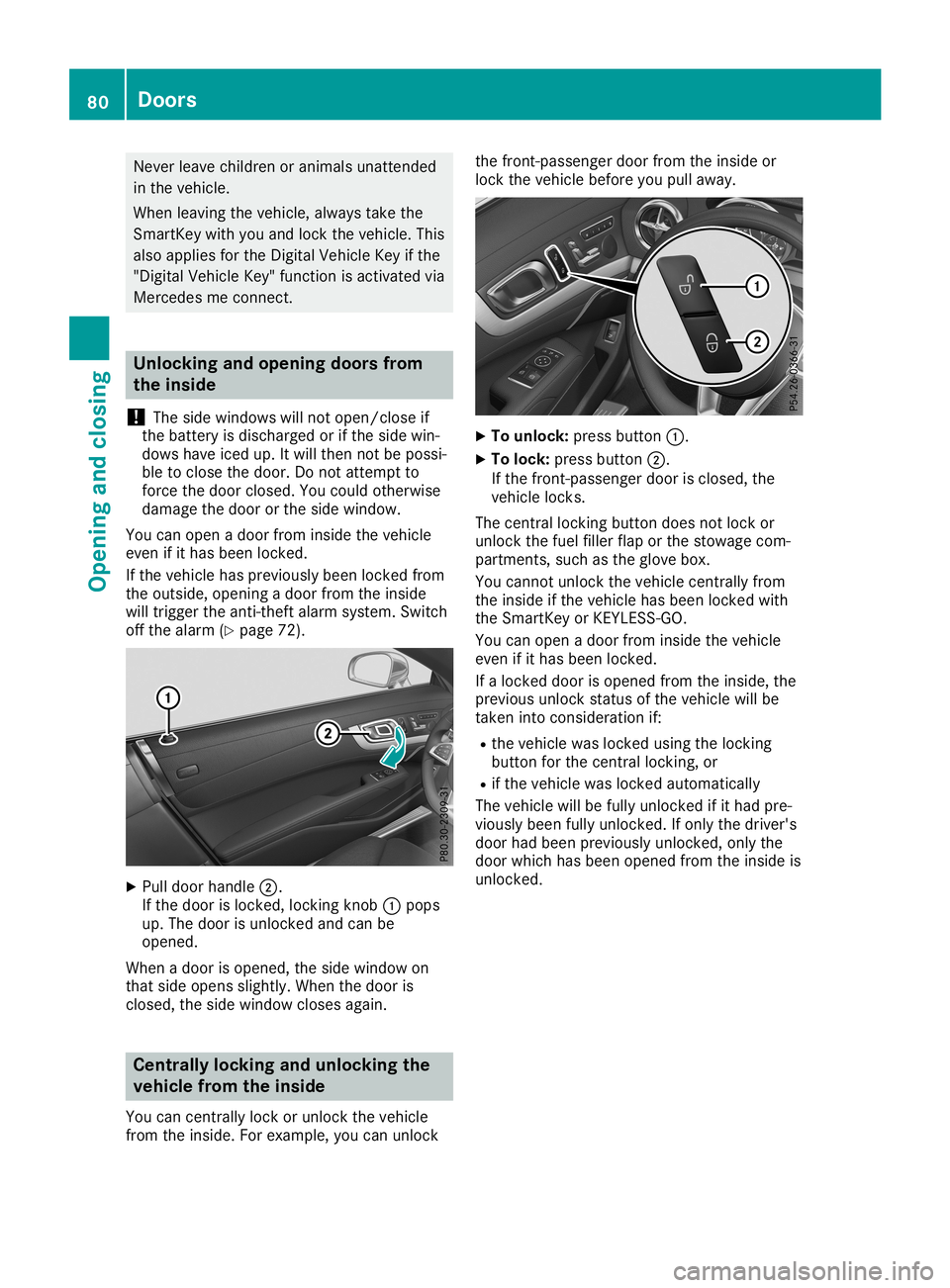
Never
leavechildren oranimal sunattended
in the vehicle.
When leavingthe vehicle, always take the
SmartKey withyouand lock thevehicle. This
also appliesforthe Digital Vehicle Keyifthe
"Digital Vehicle Key"function isactivated via
Mercedes meconnect . Unlo
cking andopeni ngdoors from
the inside
! The
side window swil lnot open/close if
the battery isdischarge dor ifthe side win-
dows haveicedup.Itwil lthen notbepossi-
ble toclose thedoor. Donot attempt to
force thedoor closed. Youcould otherwise
dama gethe door orthe side window .
You canopen adoor from inside thevehicle
even ifit has been locked.
If the vehicle haspreviou slybeen locked from
the outside ,opening adoor from theinside
wil ltrigger theanti-theft alarm system. Switch
off the alarm (Ypage 72). X
Pull door handle 0044.
If the door islocked, lockingknob0043pops
up. The door isunlocked andcanbe
opened.
When adoor isopened, theside window on
that side opens slightly .When thedoor is
closed, theside window closesagain. Cen
trally locking andunloc kingthe
vehic lefrom theinside
You cancentrally lockorunlock thevehicle
from theinside. Forexample ,you can unlock the
front- passe ngerdoor from theinside or
lock thevehicle beforeyoupullawa y. X
To unloc k:press button 0043.
X To loc k:press button 0044.
If the front- passe ngerdoor isclosed, the
vehicle locks.
The central locking buttondoesnotlock or
unlock thefuel fillerflap orthe stowage com-
partments, suchasthe glove box.
You cannot unlockthevehicle centrally from
the inside ifthe vehicle hasbeen locked with
the SmartKey orKEYLESS- GO.
You canopen adoor from inside thevehicle
even ifit has been locked.
If alocked doorisopened fromtheinside, the
previou sunlock statusofthe vehicle willbe
taken intoconsideration if:
R the vehicle waslocked usingthelocking
button forthe central locking, or
R ifthe vehicle waslocked automa tically
The vehicle willbe fullyunlocked ifit had pre-
viousl ybeen fullyunlocked. Ifonly thedriver's
door hadbeen previou slyunlocked, onlythe
door which hasbeen opened fromtheinside is
unlocked. 80
Do
orsOpeni ngand closi ng
Page 87 of 330
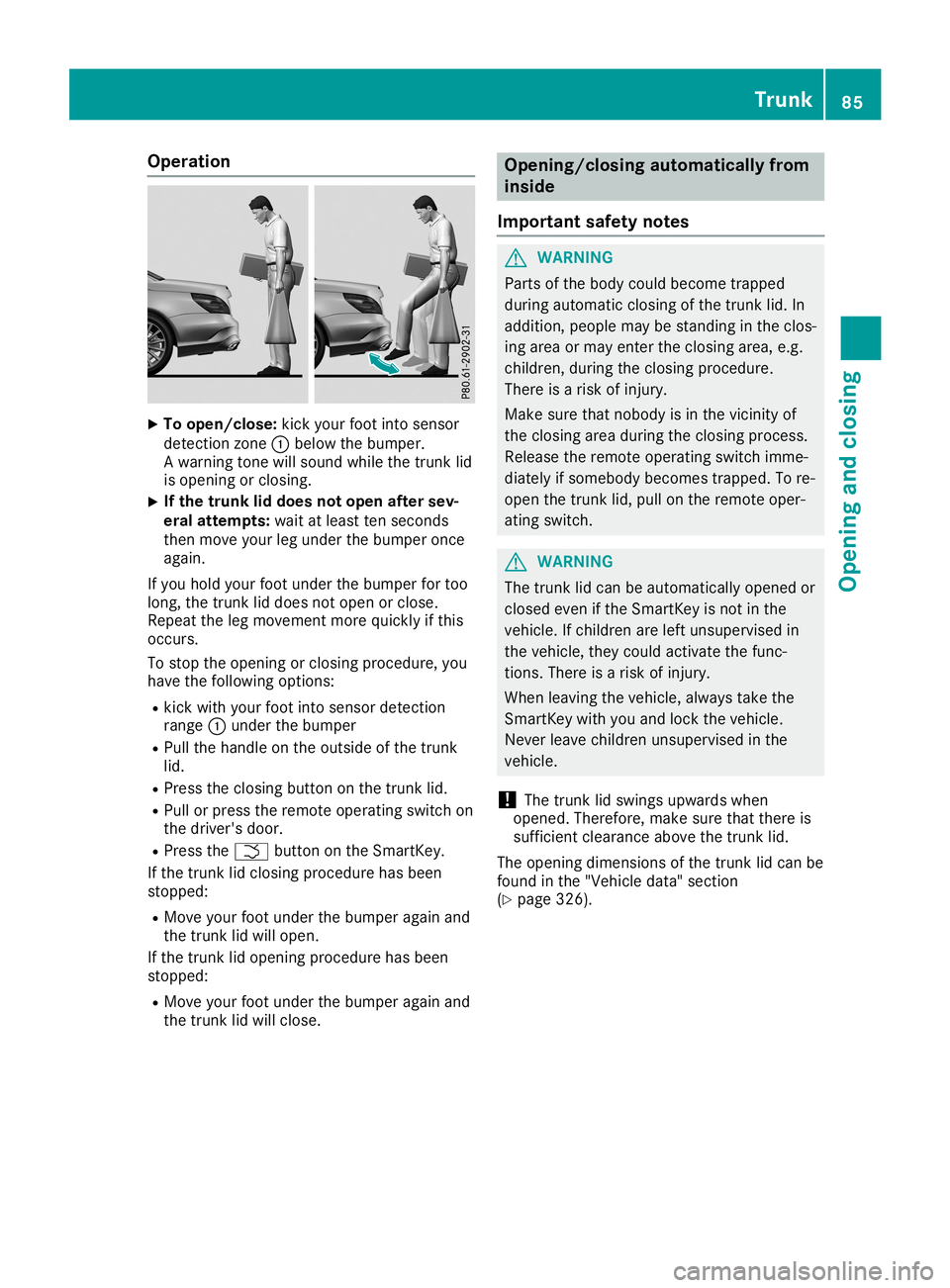
Opera
tion X
To open/close: kickyour footintosensor
detec tionzone0043 below thebumper.
A warning tonewill sound whilethetrun klid
is opening orclosing .
X If
the trunk liddoes notopen aftersev-
eral attempt s:wait atleast tensecon ds
then move yourlegunder thebumper once
again.
If you hold your footunder thebumper fortoo
long, thetrun klid does notopen orclose.
Repeat thelegmovemen tmore quickly ifthis
occurs .
To stop theopening orclosing procedure, you
have thefollowing options:
R kick with your footintosensor detection
range 0043under thebumper
R Pull thehandle onthe outside ofthe trun k
lid.
R Press theclosing buttononthe trun klid.
R Pull orpress theremot eoperatin gswitch on
the driver's door.
R Press the0054 button onthe Smart Key.
If the trun klid closing procedure hasbeen
stopped:
R Move yourfootunder thebumper againand
the trun klid will open.
If the trun klid opening procedure hasbeen
stopped:
R Move yourfootunder thebumper againand
the trun klid will close. Opening/closing
automat ically from
inside
Impor tantsafet ynotes G
WARN
ING
Parts ofthe body could become trapped
during automatic closingofthe trun klid. In
addition, peoplemaybestan ding inthe clos-
ing area ormay enterthe closing area,e.g.
children ,during theclosing procedure.
There isarisk ofinjur y.
Make surethatnobody isin the vicin ityof
the closing areaduring theclosing process .
Release theremot eoperatin gswitch imme-
diately ifsomebody becomestrapped.Tore-
open thetrun klid, pull onthe remot eoper-
ating switch. G
WARN
ING
The trunklid can beautomatic allyopened or
closed evenifthe Smart Keyisnot inthe
vehicle. Ifchildren areleft unsupervised in
the vehicle, theycould activat ethe func -
tion s.There isarisk ofinjur y.
When leaving thevehicle, alwaystake the
Smart Keywith youand lock thevehicle.
Never leavechildren unsupervised inthe
vehicle.
! The
trunklid swings upwards when
opened. Therefore,make surethatthere is
sufficien tclearanc eabove thetrun klid.
The opening dimension sof the trun klid can be
found inthe "Vehicle data"section
(Y page 326). Tr
unk
85Opening andclosi ng Z
Page 89 of 330
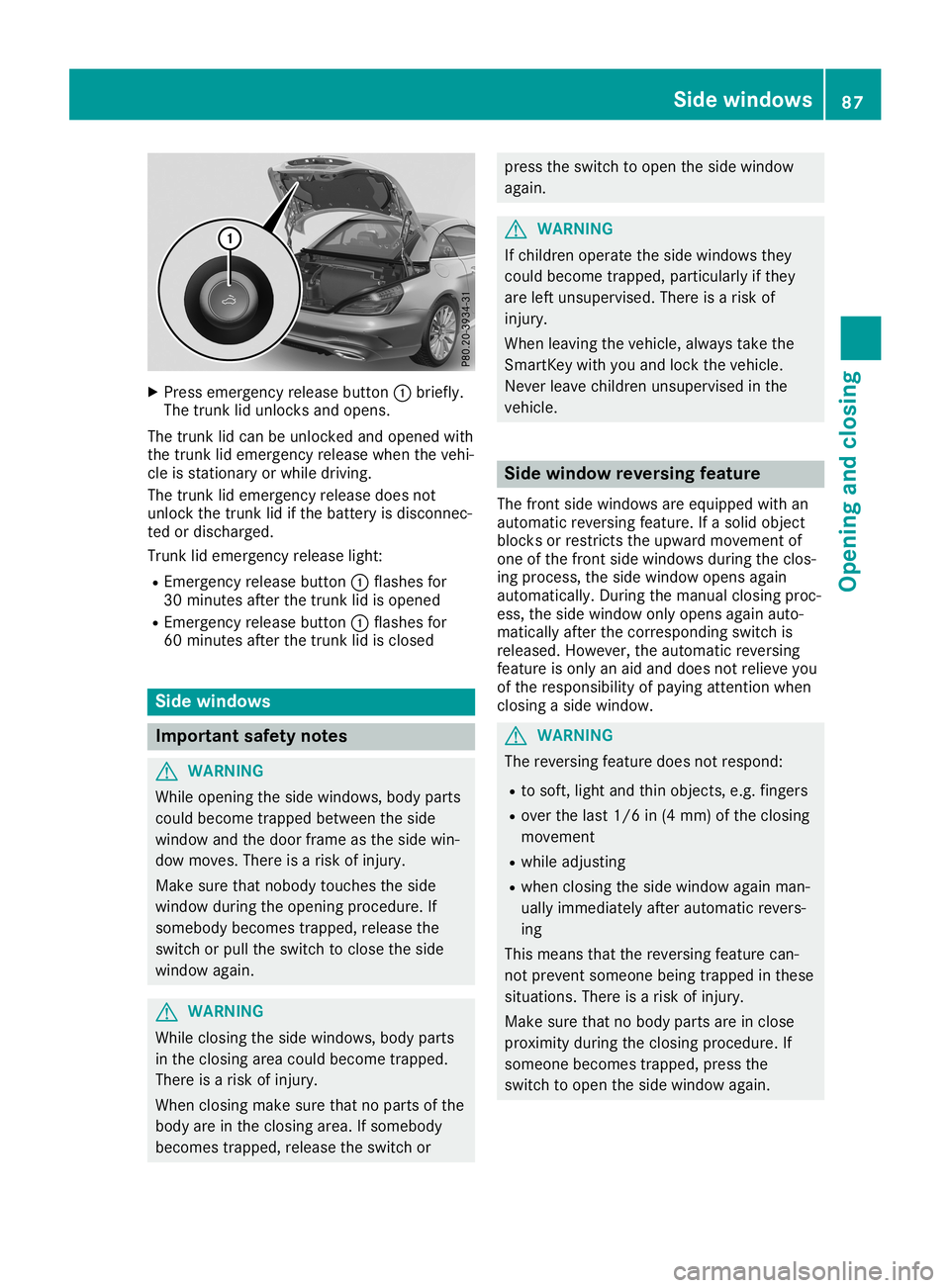
X
Press emergenc yrelease button0043briefly.
The trunk lidunlocks andopens.
The trunk lidcan beunlocked andopened with
the trunk lidemergenc yrelease whenthevehi-
cle isstation aryorwhile driving.
The trunk lidemergenc yrelease doesnot
unlock thetrunk lidifthe battery isdisconn ec-
ted ordischarged.
Trunk lidemergenc yrelease light:
R Emergen cyrelease button0043flashes for
30 minutes afterthetrunk lidisopened
R Emergen cyrelease button0043flashes for
60 minutes afterthetrunk lidisclosed Side
windows Impor
tantsafety notes G
WARNIN
G
While opening theside windows, bodyparts
could become trappedbetween theside
window andthedoor frame asthe side win-
dow moves. Thereisarisk ofinjury.
Make surethatnobody touches theside
window duringtheopening procedure. If
somebody becomestrapped,releasethe
switch orpull theswitch toclose theside
window again. G
WARNIN
G
While closing theside windows, bodyparts
in the closing areacould become trapped.
There isarisk ofinjury.
When closing makesurethatnoparts ofthe
body areinthe closing area.Ifsomebody
becomes trapped,releasetheswitch or press
theswitch toopen theside window
again. G
WARNIN
G
If children operatetheside windows they
could become trapped, particularly ifthey
are left unsupervised. Thereisarisk of
injury.
When leaving thevehicle, alwaystake the
Smart Keywith youand lock thevehicle.
Never leavechildren unsupervised inthe
vehicle. Side
window reversing feature
The frontside windows areequipped withan
automatic reversingfeature. Ifasolid object
blocks orrestr ictstheupward movemen tof
one ofthe fron tside windows duringtheclos-
ing process, theside window opensagain
automatically. Duringthemanual closingproc-
ess, theside window onlyopens againauto-
matically afterthecorrespon dingswitch is
released. However, theautomatic reversing
feature isonly anaid and does notrelieve you
of the responsibility ofpaying attentionwhen
closing aside window. G
WARNIN
G
The reversin gfeature doesnotrespond:
R to soft, lightandthin object s,e.g. fingers
R over thelast 1/6 in(4 mm) ofthe closing
movemen t
R while adjusting
R when closing theside window againman-
ually immediately afterautomatic revers-
ing
This means thatthereversin gfeature can-
not prevent someone beingtrapped inthese
situations. Thereisarisk ofinjury.
Make surethatnobody parts areinclose
proximit yduring theclosing procedure. If
someone becomestrapped,pressthe
switch toopen theside window again. Side
window s
87Opening andclosing Z